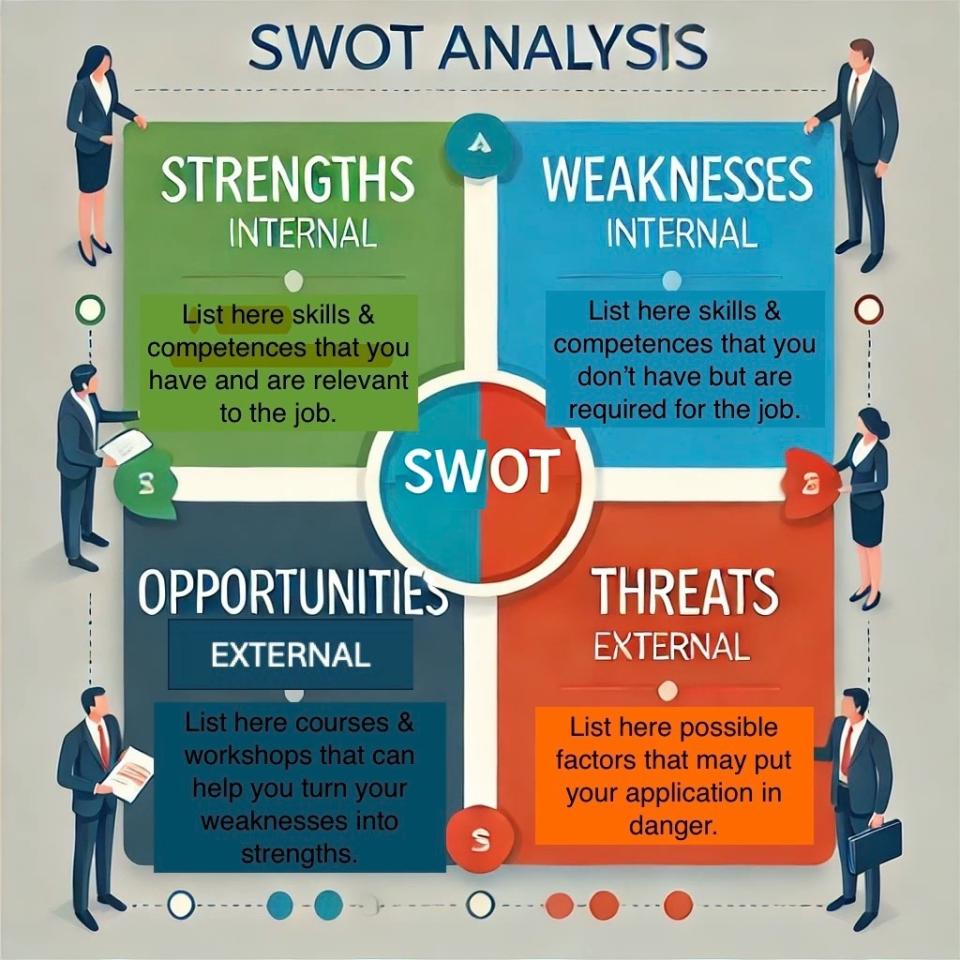In today’s competitive global job market, employers receive an overwhelming number of applications. How can educators help their students craft a compelling job application and secure the right role?
This guide presents six teaching strategies educators can deploy to help graduates enhance their job applications. In this first part, we discuss teaching your students to decode job advertisements, use SWOT analysis to align skills and craft CVs to meet job requirements.
1. Decoding job advertisements
Each job advertisement contains valuable insights into the employer’s expectations and the best ways to present them with relevant skills and experience. Understanding them can significantly improve a graduate’s chances of securing a suitable position.
Analyse the language
Using existing job ads your students are interested in, ask them to start by analysing the tone and structure of the ads. Guiding questions you can use include:
- Is the language used formal or informal?
- What does the language tell you about the recruiter?
- What skills or previous experience do they seem to prefer?
Answers to these questions can provide insight into the type of candidate the recruiter seeks. Additionally, students can determine whether the employer prioritises specific experience or values broader, transferable skills. The ability to decode these elements helps in knowing the company culture and aligning application documents effectively.
Understand key job requirements
Coupled with analysing the language, guide your students to identify the core competencies valued for the role. Employers increasingly emphasise soft skills, such as communication, problem-solving and adaptability. Ask students to look for keywords like “teamwork”, “leadership” or “analytical/critical thinking” in their specific job ad. Understanding these implicit expectations will enable students to craft applications that resonate with recruiters.
- Strategies to train students in three transferable skills wanted by employers
- Collaborating with employers to create work-ready graduates
- Sharpen your students’ interview skills
Learn specific terminology
It is equally important to teach students to identify fundamental industry-specific terminology. Creating opportunities for them to analyse several job postings from the same industry will help increase their knowledge of industry-related terms. Similarly, integrating these terms into their draft CVs and cover letters (see section 3) will show them how to demonstrate industry awareness and improve their chances of advancing through applicant tracking systems.
Use AI to decode ads
Encourage your students to use artificial intelligence tools, such as ChatGPT, to assist them in analysing job descriptions and extracting critical keywords. These tools also provide suggestions for refining CVs and drafting tailored cover letters. Plus, students using their preferred AI tool in the classroom offers the educator a chance to discuss the ethical use of such tools with the class as a whole.
2. Using SWOT analysis to align skills
Self-awareness
Self-awareness is essential for students seeking a job, particularly for those with limited professional experience. To foster a clear understanding of students’ strengths and weaknesses, educators can begin by asking them to reflect on their defining strengths:
- What tasks come naturally to you but challenge others?
- What do people often praise you for?
- What achievements, big or small, are you proud of?
- When do you feel most engaged and energised?
Students can also be made aware that, when writing CVs or preparing for interviews, they can use these to provide concrete examples. Rather than just stating, “I am a great team player”, they could illustrate their strengths through specific experiences, such as contributions to group projects.
Students also need to recognise their weaknesses, particularly in relation to job requirements. Educators can ask students self-reflection questions such as:
- What tasks do you struggle with?
- What aspects of a job make you feel disengaged?
- Which required skills do you lack?
- What challenges might you face in this role?
Matching skills to job requirements
The next exercise involves comparing the strengths and weaknesses students have identified with those required for the job. Guiding questions that educators can use include:
- How do your strengths align with the job requirements?
- Which achievements or skills should you emphasise?
- Where do you fall short?
- How can you address these gaps?
Educators can also encourage students to use a visual SWOT analysis (Strengths, Weaknesses, Opportunities and Threats) to map out personal competencies and external challenges. This structured approach provides clarity on where students stand and how they can refine their applications strategically.

Turning weaknesses into strengths
Before creating their CVs, students can use the visual SWOT analysis to recognise their weaknesses and highlight areas for improvement. Guide them to decide what targeted actions – such as online courses, workshops or internships – can help them transform weaknesses into strengths. Similarly, encourage them to analyse potential threats, such as strong competition, to enable them to develop unique selling points that set them apart. While internal factors (strengths and weaknesses) are within their control, understanding external ones (opportunities and threats) ensures a more strategic approach to job applications.
3. Crafting CVs to meet job requirements
Tailoring CVs and cover letters
When it comes to crafting CVs and cover letters, a good place to start is by discussing CV templates and your students’ approach to them. While numerous CV templates exist, such as Europass, it is important they realise that generic formats may not always align with specific job requirements. And whereas certain CV sections, such as personal details, remain fixed, others like education and work experience should be tailored to the target job.
Using the job ads they have analysed, students may be encouraged to
- identify whether the job advertisement specifies a preferred CV format
- follow the guidelines provided
- emphasise education and experience that are relevant to the role
- highlight how their skills – whether social, technical or organisational – align with the job description, providing supporting evidence where possible.
Once they have finished their analysis, ask them to revise their draft CVs to make sure they have observed these points, and start drafting a cover letter. A cover letter often accompanies a CV and should be customised for each application.
Make your students aware that their cover letter should:
- maintain a formal tone
- highlight aspects not fully covered in their CVs, such as academic achievements, extracurricular accomplishments or relevant projects
- emphasise why they are the best fit for the role and how their unique experiences add value.
Ensuring accuracy and professionalism
The next step involves guiding students to proofread their CVs and cover letters, to eliminate typos and inconsistencies. Errors may create a negative impression. Share this checklist with them.
Are your documents
- consistent in register and tone?
- free from typos and grammar mistakes?
- compliant with the employer’s requirements?
- crafted to be submitted as required (via email, online form or digital platform)?
Exploring video CVs as a strategic option
Discuss alternative CV formats with the students. For some industries, video CVs offer an innovative way to stand out. In pairs or small groups, they can watch a few examples and then discuss how to create concise, engaging videos that highlight their skills and personality effectively.
Teaching students how to analyse the content, the language and the requirements of job ads in relation to what they have to offer will help them craft a more compelling application, and improve their chances of being shortlisted for an interview.
Julio Gimenez is principal lecturer at the Centre of Education and Teaching Innovation (CETI) at the University of Westminster. Juan C. Palmer is senior lecturer in English philology and director of the master’s programme in English language for international trade, and Miguel F. Ruiz-Garrido is senior lecturer in English philology and work placement coordinator of the master’s programme in English language for international trade, both at Universitat Jaume I.
If you’d like advice and insight from academics and university staff delivered direct to your inbox each week, sign up for the Campus newsletter.




comment